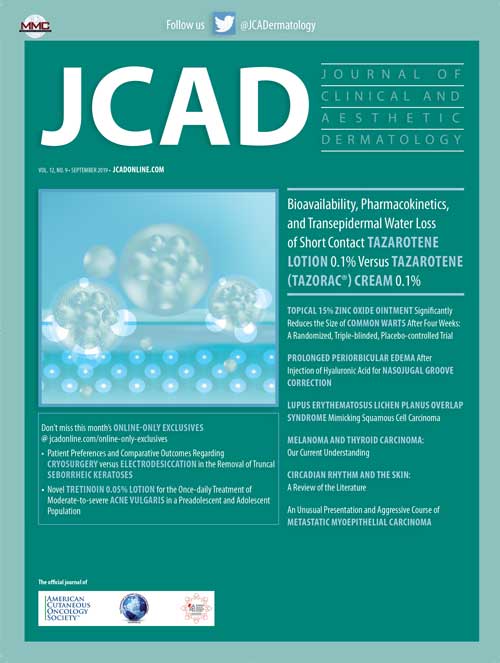 Dear Colleagues:
Dear Colleagues:
Welcome to the September 2019 issue of The Journal of Clinical and Aesthetic Dermatology. We begin the issue with an article by Sidgiddi et al, which reports the results of two clinical studies: one that assessed the pharmacokinetic (PK) properties of tazarotene and tazarotenic acid in DFD-03 lotion (a 1-minute, short-contact formulation for the topical treatment of acne vulgaris) and tazarotene cream 0.1%; and another that evaluated transepidermal water loss (TEWL) with DFD-03 lotion, tazarotene gel (0.1%), or vehicle in healthy adults aged 18 to 40 years. The authors concluded that DFD-03 lotion was well-tolerated, increased TEWL when applied twice daily for one minute, and had a PK profile with similar overall exposure compared with commercially available tazarotene formulations applied once daily for 12 hours.
Next, we present original research from Songsantiphap and Asawononda, in which they evaluated the efficacy of topical 15% zinc oxide ointment for the treatment of common warts. Sixteen patients with two comparable palmar warts, or verruca vulgaris, were randomized to receive either 15% zinc oxide ointment or placebo three times a day for four weeks. At Week 4, zinc oxide significantly reduced the median surface area compared to baseline (P<0.037). However, when the median percent changes between groups were compared, there were no statistically significant differences.
After this, Vasquez et al discuss the case of a 61-year-old Caucasian woman with prolonged infraorbital hollow edema after injection of hyaluronic acid (HA) filler for nasojugal groove correction. After monitoring the prolonged edema for 18 months, the physicians injected 0.05mL of hyaluronidase bilaterally into the area of greatest nasojugal edema 19 months after initial HA injection, then injected another 0.02mL of hyaluronidase 25 months post-initial HA injection, with notable improvement. The authors then review the anatomy of the nasojugal area, differing injection techniques, and rheological properties of the specific hyaluronic acid used during this procedure as possible explanations for the development of prolonged edema.
Next, Smirnov et al present the case of a 42-year-old Caucasian woman with a medical history of systemic lupus erythematosus who was referred for surgery for photodistributed hyperkeratotic annular papules and plaques formerly histologically interpreted as squamous cell carcinoma of the bilateral arms. The patient was eventually diagnosed with lupus erythematosus lichen planus (LE-LP) overlap syndrome, which combines both the histologic and clinical features of lupus erythematosus and lichen planus.
Following that, Lazzara et al offer a mini-review of the association between melanoma and thyroid carcinoma. The authors conducted a systematic review of PubMed Central and ScienceDirect online, and they discuss research supporting their theory that thyroid dysfunction is disproportionately noted among patients with a history of melanoma.
Next, we present another review, in which Lyons et al reviewed the current literature on circadian rhythm effects on the skin and describe and discuss its basic principles. The authors discuss how the circadian rhythm plays a specific role in various skin conditions, including atopic dermatitis, photodamage, psoriasis, and skin cancer, and review how dermatologists can optimize the therapeutic benefit of topical medications and skincare products in their patients through instruction for use at certain times of the day or night.
Next, we present a case report by Zeitouni et al, titled, “An Unusual Presentation and Aggressive Course of Metastatic Myoepithelial Carcinoma.” Here, the authors discuss a case of a 55-year-old man with myoepithelial carcinoma that developed into widespread cutaneous, lung, and brain metastases refractory to treatment, including newer immunotherapies.
In our first online-only exclusive article, Ethington et al present their randomized, blinded clinical trial in which they evaluated the comparative efficacy and patient preferences of cryosurgery and electrodesiccation for the treatment of truncal seborrheic keratosis (SK) lesions. Here, 33 subjects, each with at least two truncal SK lesions, were treated with cryosurgery on one lesion and electrodesiccation on another. Patients rated their pain and preference at the time of treatment and follow up at two and eight weeks. Physicians rated the color, texture, and efficacy of lesion removal at eight weeks. According to patient responses, they did not have a treatment preference. Both modalities were effective in removing the SK lesions; however, cryosurgery resulted in less postinflammatory hyperpigmentation.
St. Surin-Lord et al evaluated the safety and efficacy of tretinoin 0.05% lotion in preadolescent (?13 years) and adolescent (14–17 years) subjects with acne vulgaris. In this post-hoc analysis of two multicenter, randomized, double-blind, vehicle-controlled Phase III studies, preadolescent (n=154) and adolescent (n=575) subjects were randomized (1:1) to tretinoin 0.05% lotion or vehicle applied once daily for 12 weeks. The authors concluded that tretinoin 0.05% lotion was significantly more effective than the vehicle in achieving treatment success and reducing inflammatory and noninflammatory lesions in preadolescent and adolescent acne. Our online-only exclusives can be accessed by visiting jcadonline.com/online-only-exclusives/ or via the e-Edition by visiting jcad.mydigitalpublication.com/publication/?m=54680&l=1.
We hope you enjoy this issue of JCAD. As always, we welcome your feedback and submissions.
With regards,
James Q. Del Rosso, DO, FAOCD—Editor-in-Chief, Clinical Dermatology
Wm. Philip Werschler, MD, FAAD, FAACS—Editor-in-Chief, Aesthetic Dermatology
Seemal R. Desai, MD, FAAD— Associate Editor

